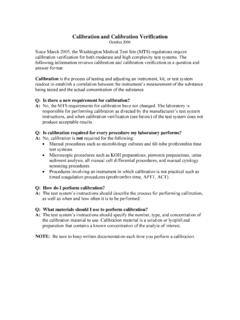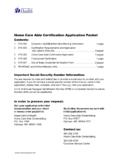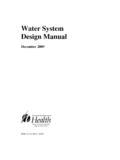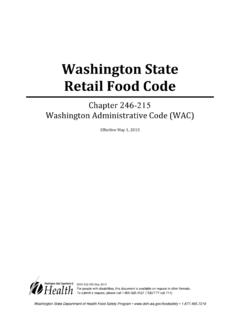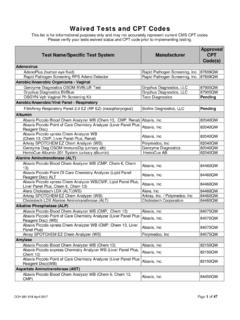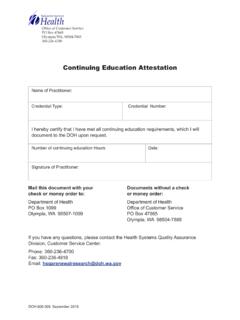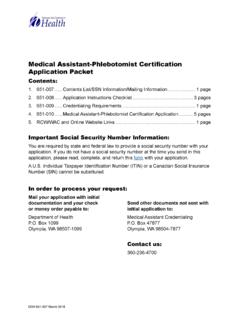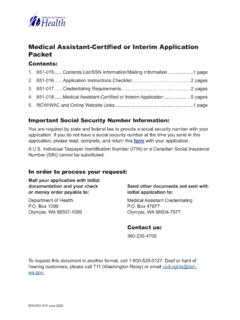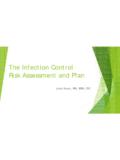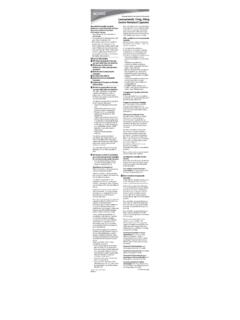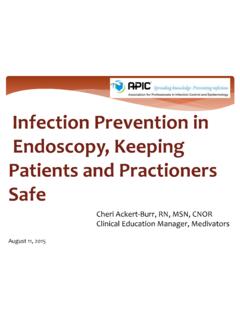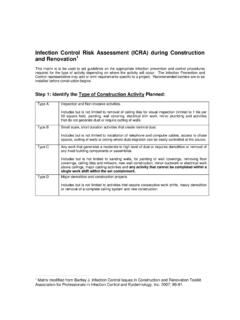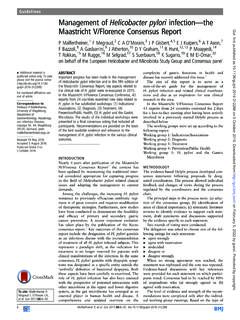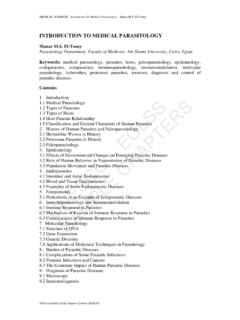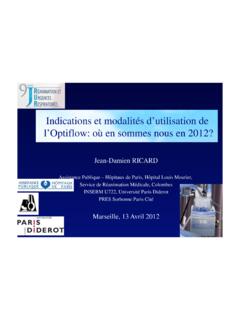Transcription of COVID-19 Infection Control for Aerosol Generating Procedures
1 0 Interim Recommendations for SARS-CoV-2 Infection prevention and Control in Healthcare Settings 2022 Interim Recommendations for SARS-CoV-2 Updated April 22, 2022 DOH 420-391 Updated April 22, 2022 DOH 420-391 1 Table of Contents BACKGROUND AND PURPOSE .. 3 KEY INFORMATION .. 3 Infection prevention AND Control PROGRAM AND PLAN .. 4 ELEMENTS OF COVID-19 prevention IN ALL HEALTHCARE SETTINGS .. 5 SCREENING .. 5 HAND HYGIENE .. 6 PHYSICAL DISTANCING .. 6 ENVIRONMENTAL Infection Control - CLEANING AND DISINFECTION .. 7 VENTILATION .. 8 PERSONAL PROTECTIVE EQUIPMENT (PPE) AND TRANSMISSION-BASED PRECAUTIONS (TBP) .. 8 TABLE 1: PPE PATIENTS, HCPS, AND VISITORS SHOULD WEAR IN HEALTHCARE SETTINGS .. 10 TABLE 2: HCPS: HOW TO USE PPE .. 11 SOURCE Control .. 12 SOURCE Control VERSUS PPE .. 12 TABLE 3: SOURCE Control AND PPE PROTECTION.
2 13 SOURCE Control FOR PATIENTS AND VISITORS .. 14 SOURCE Control FOR HEALTHCARE PERSONNEL .. 14 FACEMASK USE IN HEALTHCARE SETTINGS .. 15 IMPROVING THE FIT OF MASKS IN HEALTHCARE SETTINGS .. 16 PRECAUTIONS DURING AND FOLLOWING Aerosol Generating AND OTHER Procedures .. 16 Aerosol - Generating Procedures AND Procedures THAT CREATE UNCONTROLLED RESPIRATORY SECRETIONS .. 17 HEALTHCARE PERSONNEL EXEMPTIONS TO RESPIRATOR USE FOLLOWING AN Aerosol - Generating PROCEDURE .. 19 PATIENT ISOLATION AND QUARANTINE .. 20 ISOLATION VERSUS QUARANTINE .. 21 TABLE 4: SUMMARY OF SARS-COV-2 ISOLATION VERSUS QUARANTINE .. 21 HEALTHCARE PERSONNEL EXPOSURE AND EXCLUSION FROM WORK .. 22 STRATEGIES TO MITIGATE HEALTHCARE PERSONNEL STAFFING SHORTAGES .. 22 TABLE 5: SUMMARY OF CDC S RECOMMENDATIONS FOR HCP EXCLUSION FROM WORK ACCORDING TO STAFFING MITIGATION 24 CONSIDERATIONS FOR SHORTENED EXCLUSION FROM WORK FOR HEALTHCARE PERSONNEL AFTER A HIGH-RISK EXPOSURE TO SARS-COV-2.
3 25 CONSIDERATIONS FOR SHORTENED EXCLUSION FROM WORK FOR HEALTHCARE PERSONNEL WITH SARS-COV-2 Infection .. 26 TRANSFERRING BETWEEN FACILITIES .. 26 TESTING .. 27 TESTING PRIORITIZATION .. 27 EXAMPLE OF LTCF PRIORITIZATION FROM HIGHEST (1) TO LOWEST (3) .. 28 TABLE 6: TESTING SUPPLY PRIORITIZATION .. 28 DETERMINING EXPOSURE .. 29 2 GUIDANCE FOR SPECIFIC SETTINGS .. 30 TRANSFERRING BETWEEN FACILITIES .. 30 TRANSFERRING FROM A LTCF TO ANOTHER HEALTHCARE SETTING .. 30 HOSPITAL ADMISSION .. 31 TRANSFERRING FROM A HOSPITAL OR OTHER HEALTHCARE SETTING TO LTCF .. 31 TABLE 7: RECOMMENDED COHORTING STRATEGY .. 38 PLACEMENT OF RESIDENTS IN QUARANTINE .. 34 OBSERVATION/QUARANTINE BEST PRACTICES WHEN SINGLE-PERSON ROOM IS UNAVAILABLE .. 34 TABLE 8: CONSIDERATIONS FOR COHORTING WHEN A SINGLE ROOM IS NOT AVAILABLE .. 35 CONSIDERATIONS FOR MEMORY CARE UNITS.
4 36 SYMPTOMS IN MEMORY CARE RESIDENTS .. 37 PPE CONSIDERATIONS .. 37 TABLE 9: ROUTINE TESTING FOR ALL LTCF STAFF .. 38 BEHAVIORAL HEALTH .. 41 ACUTE CARE .. 43 ADDITIONAL RESOURCES .. 46 OUTBREAK DEFINITION IN HEALTHCARE SETTINGS .. 46 OUTBREAK AND PREPAREDNESS CHECKLISTS .. 46 VISITOR LOG .. 59 SIGNS AND OTHER TOOLS .. 61 DEFINITIONS .. 62 ABBREVIATIONS .. 67 CHANGE LOG .. 68 MORE COVID-19 INFORMATION AND RESOURCES .. 68 3 Background and Purpose This document includes Washington State Department of Health (DOH) recommendations to prevent transmission of severe acute respiratory syndrome coronavirus 2 (SARS-CoV-2), the virus that causes coronavirus disease 2019 ( COVID-19 ) in healthcare settings. Healthcare settings should use these recommendations to create flexible policies specific to their facility based on their individual risk assessment reflecting CDC s community levels of transmission.
5 In general, healthcare settings should follow Centers for Disease Control and prevention (CDC) guidance to prevent transmission of SARS-CoV-2: Interim Infection prevention and Control Recommendations for Healthcare Personnel (HCP) During the COVID-19 Pandemic Overview of Testing for SARS-CoV-2, the virus that causes COVID-19 Interim Guidance for Managing HCP with SARS-CoV-2 Infection or Exposure to SARS-CoV-2 Strategies to Mitigate HCP Staffing Shortages Interim Infection prevention and Control Recommendations to Prevent SARS-CoV-2 Spread in Nursing Homes Summary for Healthcare Facilities: Strategies for Optimizing the Supply of Personal Protective Equipment (PPE) during Shortages The guidance in this document is not regulatory in nature except when required by a regulatory agency such as Washington State Labor & Industries (L&I), Washington State Department of Social and Health Services (DSHS), DOH-Health Systems Quality Assurance (HSQA), and Centers for Medicaid and Medicare Services (CMS).
6 When creating policy and Procedures , healthcare settings should ensure they are meeting regulatory requirements. The guidance in this document is interim in nature and, as such, will be updated with changes in national and state guidance and most recent evidence and data. Changes will be summarized in the change log. Key Information DOH COVID-19 public health reporting and surveillance guidelines provide useful key information about COVID-19 including information on incubation period, mode of transmission, and period of communicability. For updated case counts: Washington: US: #cases_casesinlast7days Global: 4 Infection prevention and Control Program and Plan Healthcare facilities should have a person dedicated to Infection prevention and Control and a plan to mitigate risk of Infection transmission. Some healthcare settings have specific regulatory requirements for Infection prevention and Control .
7 Please refer to regulatory agencies (L&I, DSHS, HSQA, and CMS) requirements for regulatory requirements. An Infection prevention and Control program should at minimum include: 1) Guidelines, policies, and Procedures 2) Education and training 3) Surveillance 4) Monitoring, audit, and feedback From: WHO s core components of Infection prevention and Control program 5 Elements of COVID-19 prevention in all Healthcare Settings Screening Follow CDC recommendations to establish a process to identify anyone entering the facility, regardless of their vaccination status, who meets any of the following three criteria so that they can be properly managed: A positive viral test for SARS-CoV-2, or Symptoms of COVID-19 , or Close contact with someone with SARS-CoV-2 Infection (for patients and visitors) or a higher-risk exposure (for HCP). Options could include (but are not limited to): individual screening on arrival at the facility; or implementing an electronic monitoring system in which individuals can self-report any of the above before entering the facility.
8 DOH has visitor screening and healthcare worker screening tools available for adaptation. Visitors who are not moderately to severely immunocompromised and have recently had mild to moderate SARS-CoV-2 Infection should not visit until: Symptoms improve with no fever in the last 24 hours and no fever reducing medication AND 10 days from onset of symptoms or positive test if asymptomatic OR 7 days from onset of symptoms with a negative SARS-CoV-2 antigen test collected within 48 hours Visitors who are not up to date with COVID-19 vaccines and have had close contact (defined as within 6 feet for 15 cumulative minutes in 24 hours) should not visit until: 10 days from last date of close contact OR 7 days from last date of close contact with a negative SARS-CoV-2 antigen or nucleic acid amplification test (NAAT) test, such as a polymerase chain reaction (PCR) test, collected within 48 hours Healthcare facilities do not need to verify visitor vaccination status, test status, severity of disease, or immunological status.
9 Exclude HCP according to recommendations for CDC s HCP Exposure and Exclusion from Work and DOH Mitigating Healthcare Worker Staffing Shortage. 6 Hand Hygiene Follow CDC recommendations for hand hygiene. HCP should use an alcohol-based hand rub containing at least 60 percent alcohol or wash with soap and water for the following clinical indications: Immediately before touching a patient Before performing an aseptic task (for example, placing an indwelling device) or handling invasive medical devices Before moving from work on a soiled body site to a clean body site on the same patient After touching a patient or the patient s immediate environment After contact with blood, body fluids, or contaminated surfaces Immediately after glove removal Handwashing with soap and water should be done after using the restroom and when hands are visibly soiled.
10 At other times, an alcohol-based hand rub is preferred over soap and water due to evidence of better compliance compared to soap and water. Physical Distancing Follow CDC recommendations for physical distancing in healthcare settings. Physical distancing (when physical distancing is feasible and will not interfere with provision of care) is recommended for everyone in a healthcare setting. This is particularly important for individuals, regardless of their vaccination status, who live or work in counties with substantial to high community transmission or who: Are not up to date with all recommended COVID-19 vaccine doses; or Have suspected or confirmed SARS-CoV-2 Infection or other respiratory Infection (for example, those with runny nose, cough, sneeze); or Had close contact (patients and visitors) or a higher-risk exposure (HCP) with someone with SARS-CoV-2 Infection for 10 days after their exposure, including those residing or working in areas of a healthcare facility experiencing SARS-CoV-2 transmission; or Have moderate to severe immunocompromise; or Have otherwise had source Control and physical distancing recommended by public health authorities.
